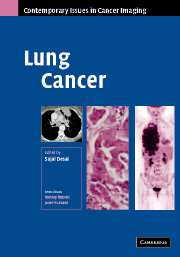Book contents
- Frontmatter
- Contents
- Contributors
- Series Foreword
- Introduction
- 1 Clinical Considerations in Lung Cancer
- 2 Pathology of Lung Cancer
- 3 Imaging of Lung Cancer
- 4 Screening for Lung Cancer
- 5 Staging of Lung Cancer
- 6 Positron Emmision Tomography in Lung Cancer
- 7 Contemporary Issues in the Systemic Treatment of Lung Cancer
- 8 Radiotherapy in Lung Cancer
- 9 Surgery for Lung Cancer
- Index
- Plate Section
- References
6 - Positron Emmision Tomography in Lung Cancer
Published online by Cambridge University Press: 12 August 2009
- Frontmatter
- Contents
- Contributors
- Series Foreword
- Introduction
- 1 Clinical Considerations in Lung Cancer
- 2 Pathology of Lung Cancer
- 3 Imaging of Lung Cancer
- 4 Screening for Lung Cancer
- 5 Staging of Lung Cancer
- 6 Positron Emmision Tomography in Lung Cancer
- 7 Contemporary Issues in the Systemic Treatment of Lung Cancer
- 8 Radiotherapy in Lung Cancer
- 9 Surgery for Lung Cancer
- Index
- Plate Section
- References
Summary
Introduction
PET is a nuclear medicine imaging technique which, following injection of a positron emitting radiopharmaceutical, results in functional tomographic images. PET shares the advantages of nuclear medicine imaging over other radiological techniques including the ability to map function/metabolism before alterations in structure. In addition, some of the disadvantages of conventional nuclear medicine are overcome, in that spatial resolution of images is much improved and tomographic imaging is routine rather than an additional acquisition. Another advantage of PET is that it is relatively easy to measure and correct for the attenuation of photons that leave the body. This means that it is possible to measure radioactive concentrations accurately within tissues and, if necessary, express physiological processes in absolute units. The most widely used and computationally simple method of quantitation in clinical PET is the standardized uptake value (SUV). This is a semiquantitative index that measures the concentration of tracer within a tumour compared to the injected dose and is normalized to body weight. It has the potential to be an index of tracer uptake that can be compared between patients and at different time periods within the same patient and is commonly quoted in clinical PET publications.
PET has advanced in the last 15 years from being primarily a research tool to being an imaging modality with a number of clinical applications.
- Type
- Chapter
- Information
- Lung Cancer , pp. 84 - 98Publisher: Cambridge University PressPrint publication year: 2006



